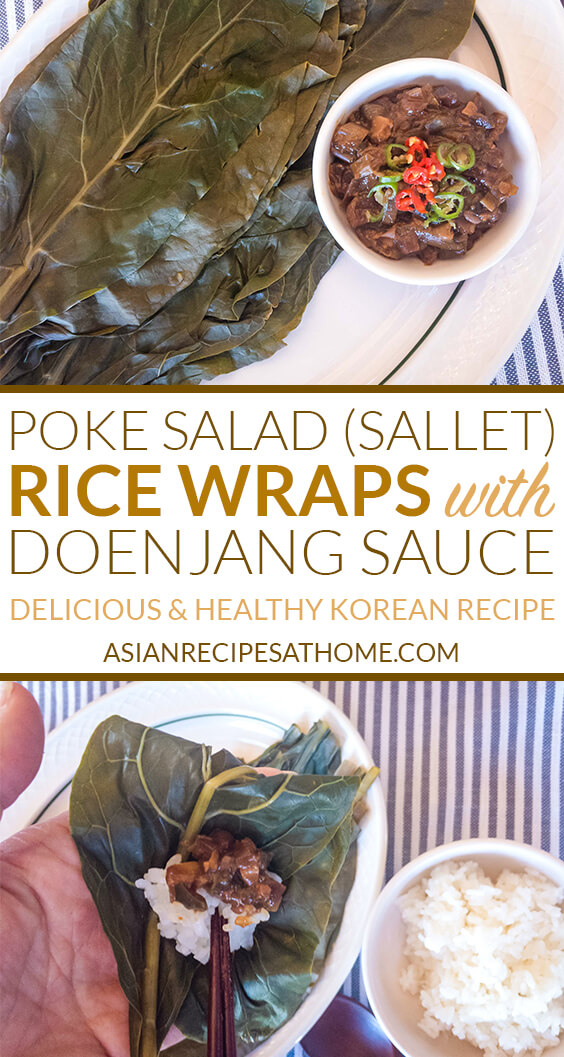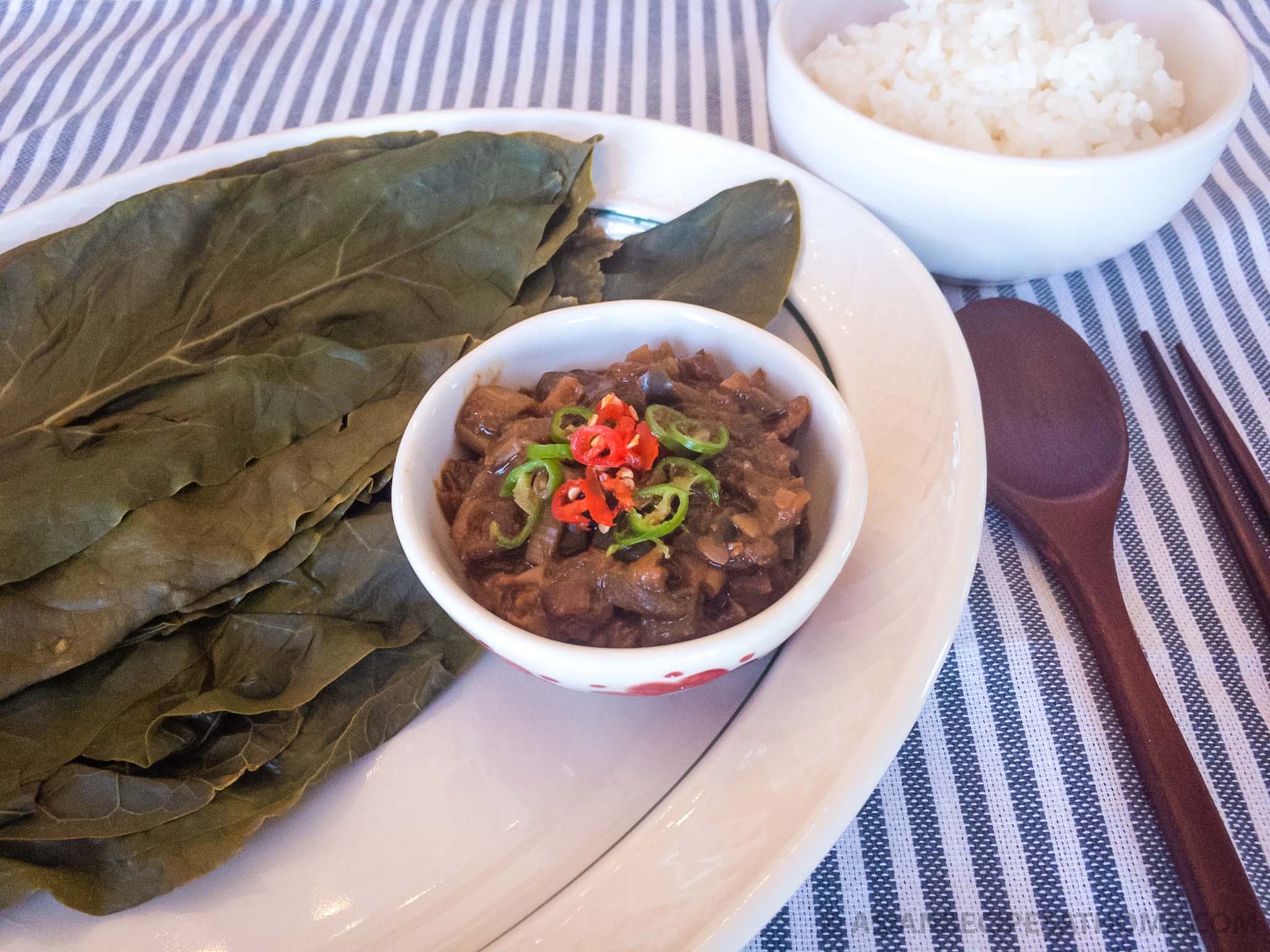Boiled poke salad (sallet) leaves are used as the wrap for the rice and the savory, salty Korean fermented soybean paste sauce. It is a light and healthy meal that can easily be transformed into a vegetarian or vegan compliant meal with one ingredient swap.
This recipe is so easy, yet delivers on great flavor. With the neutral flavors from the plain poke salad (sallet) leaves and steamed white rice, the fermented soybean paste sauce is what adds a great depth of salty and savory flavor. You just need to try these rice wraps!
What is Korean fermented soybean paste (doenjang)?
Korean fermented soybean paste, also known as doenjang (pronounced DEN-jahng), is typically entirely made up of soybeans and brine. It is made by fermenting cooked soybeans with salt for a long time, usually at least 6 months or more. Doenjang has a salty, sometimes slightly sour, and umami flavor profile that really adds a great depth of flavor to Korean cuisine.
Ways to Eat or Use Doenjang
Having extra doenjang is never a bad thing. You might be scared to buy a tub of it, but don’t worry, there are many ways to eat and use up all that doenjang. Growing up, we would take the raw paste and just dip freshly cut cucumbers into it or even mild peppers, just like a condiment. It’s so simple, yet delicious eating doenjang this way.
Doenjang is also known to be used as the base of ssamjang. Ssamjang is basically a combination of doenjang and hot red pepper paste (gochujang), along with a few other ingredients to create a paste to use in rice wraps. In Korea, many people typically eat ssamjang by placing rice on a piece of lettuce and adding a sizable amount of ssamjang on top. Many also love having this leafy vegetable and rice combination with doenjang or ssamjang with their meat dishes such as samgyeopsal, bulgogi, bibimbap, and bossam.
Doenjang is also very widely used as the base of soup broth, like for the well-known Korean soup/stew, Doenjang Jjigae. We have several soup recipes that utilize doenjang here on our site, such as:
- Korean Poke Salad (Sallet) Soybean Paste Stew (Doenjang Jjigae)
- Korean Spinach and Mussel Fermented Soybean Paste (Doenjang) Soup
- Korean Green Onion Fermented Soybean Paste (Doenjang) Soup
Potential Health Benefits of Doenjang
Doenjang is known for its anti-carcinogenic properties and benefits. So much so that in an online article by Chefs Society, it was stated that “the Korean Cancer Prevention Association has recommended daily consumption of Doenjang-guk (Soybean Paste Soup) for cancer prevention”. Wow! The Korean Cancer Prevention Association is recommending daily consumption of doenjang!
There have been studies done on rodents with promising results of reducing visceral fat. There was one study done on humans and it showed significant improvements in reducing visceral fat compared to the placebo group after 12 weeks.
Ingredients Needed For This Recipe
- 16-20 poke salad (sallet) leaves*
- 2 cups cooked medium-grain rice
For the doenjang sauce:
- 4 Tbsp Korean fermented soybean paste (doenjang)
- 4 large-sized jalapenos, stems/seeds removed and diced fine (about 1 cup)
- 1 medium-sized yellow/white onion, diced (about 1 cup)
- 4 green onions, chopped (about 1 cup)
- 1 Tbsp Dasida beef powder soup stock (if you want to make this a vegan/vegetarian recipe, substitute this with a mushroom umami powder or vegan beef bouillon)
- 1 cup water
How to Make Our Poke Salad (Sallet) Rice Wraps with Doenjang Sauce
- First, let’s properly prepare the poke salad (sallet) leaves to remove the toxins as much as possible. Remember, to never eat poke salad in its raw form. If you want to learn more about the process of properly preparing pokeweed in detail, then look at our dedicated post here.
- Place a pot with water on high heat. Allow it to come to a boil, and add the leaves. Turn the heat down to medium-high heat and continue cooking for about 6 minutes.
- Drain the poke salad leaves, rinse well. Place the leaves in a large-sized bowl or pot, and cover with cold, freshwater. Set aside on the counter and let it soak for at least 48 hours. Within the 48 hours, drain and add fresh, cool water to fully submerge the leaves again at least 2 times. Feel free to change the water more times than this if it makes you feel more comfortable.
- While your leaves are soaking, let’s make the doenjang sauce. Mix the water, doenjang, jalapenos, and yellow/white onions together in a medium-sized pot. Place on medium-high heat and allow it to come to a boil. Once it reaches a boil, turn it down to low heat/simmer. Continue cooking uncovered for about 1.5 hours to 2 hours and stir it intermittently.
- Add in the green onions and continue cooking until the water has evaporated it is all done. One the water has evaporated and has turned into a paste (almost like a ketchup consistency), then add in the Dasida beef powder soup stock. Mix together well and remove from heat. Store in an airtight container in the fridge until the poke salad (sallet) leaves are ready to use.
- Once the 48 hours is up, drain and squeeze out as much water as possible. Layout the leaves on a dish.
- Grab the warm cooked rice and your doenjang sauce you made and get to wrappin’! Enjoy!
We hope you enjoy this Poke Salad (Sallet) Rice Wraps with Doenjang Sauce recipe!
Need More Delicious Recipes?
- Korean Poke Salad (Sallet) Soybean Paste Stew (Doenjang Jjigae)
- Rice with Black Bean Sauce (Jjajangbap 짜장밥)
- Upgraded Instant Ramen Recipe Hack
- Best and Easiest Beef Bulgogi
HUNGRY FOR MORE? Subscribe to our newsletter and follow along on Facebook, Pinterest, Twitter, and Instagram for all of the latest updates.
Boiled poke salad (sallet) leaves are used as the wrap for the rice and the savory, salty Korean fermented soybean paste sauce. *If you do not know how to properly harvest and prepare pokeweed to remove the toxins prior to use in any recipe, then please do your own research on the topic first & use it at your own risk. There are a ton of resources and how-to's online with a simple Google search. We have our own how to harvest and prepare pokeweed post here as well. It explains how we prepare pokeweed prior to using it in any recipe. **If you want to make this a vegan/vegetarian recipe, substitute this with a mushroom umami powder or vegan beef bouillon.
Poke Salad (Sallet) Rice Wraps with Doenjang Sauce
Ingredients
For the doenjang sauce:
Instructions
Notes
Disclaimer: Under no circumstances shall this website and the author(s) be responsible for any loss or damages resulting from the reliance of the given nutritional information or ingredient/product recommendations. Recommended ingredients/products can change their formula at any time without this website and author’s awareness. It is your responsibility (the reader’s) to check the label/ingredients of any product prior to purchasing and/or using. We greatly appreciate your support and understanding.



